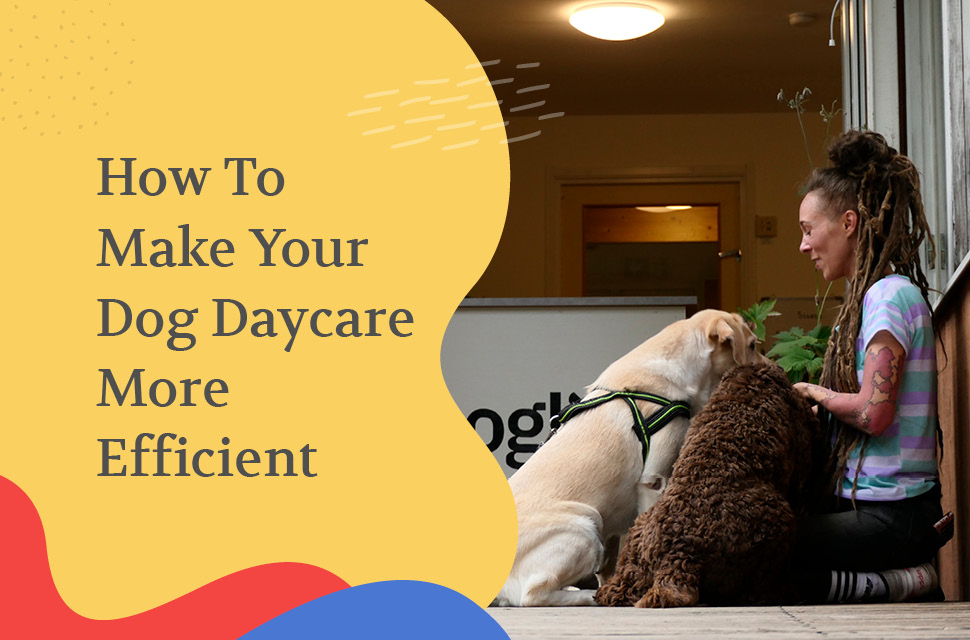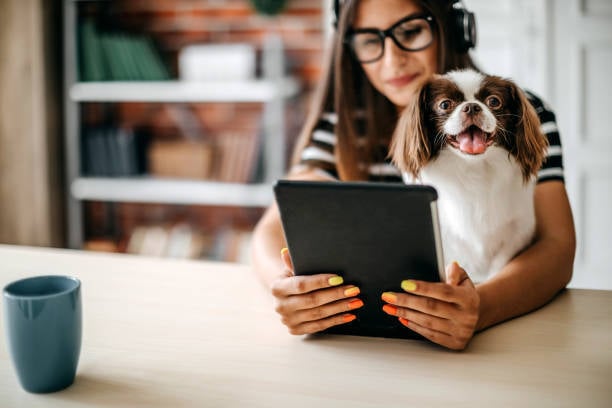By: Rachel Ellison, DVM
Did you know there are 80 million dogs owned in 50 million houses across the United States? And what’s more, a staggering 27% of these owners have utilized doggy daycare within the last 12 months! That’s a lot of opportunities to allow dogs to have a supervised, safe environment that allows for exercise, socialization, and mental stimulation.
So, how can a dog daycare business grow and differentiate itself from the pack? One of the key ingredients is to improve efficiency. An efficient doggy daycare will allow for as much productivity as possible with few wasted resources in an organized and proficient way. How can one achieve this? We’ll discover numerous ideas in this article, so let’s be efficient and get started!
1. Define The Business
Whether your company is in the planning stages or more established, is solely a dog daycare or combined with a boarding center, there are many resources available to have a great business plan.
A business plan does not need to be complex, but it needs to be in writing, and it needs to accurately reflect your business vision in a way that will allow you to easily assess day-to-day operations. These things will help you hone in on what’s important, which can help you prioritize and focus on achieving big-picture goals, which can in turn make the dog daycare more efficient.
Here are some fundamental ideas for writing a solid business plan:
- What is a business owner’s ‘why?’
- Create a mission statement and vision
- Recognize core values
- Identify the business’s audience or customer base
- Identify and bring focus to the services (and products) one will offer
- Perform a SWOT analysis (Strengths, Weaknesses, Opportunities, Threats)
- Break down specific goals into manageable chunks of time
- Play to your advantage—doggy daycare has pros that other services can’t provide—play these up!
2. Delegation
As an owner or manager, this is key to maximizing efficiency. Running a successful business takes a variety of roles; it’s not reasonable, or feasible, to expect one person to fill them all! Because you can’t do this alone, you’ll need trusted, responsible, help to whom you can transfer tasks.
Delegation can be done within house to staff and with external business-to-business services.
When delegating work in-house, know the strengths of your team. Maybe there’s an outgoing extrovert who would do great answering phones and greeting customers, but a more introverted employee who may enjoy working 1-on-1 by supervising the dogs during daily activities.
Dog trainers or employees interested in dog behavior can ensure that negative behaviors are not displayed among attending dogs.
Outline tasks with to-do lists and expected job duties for individual staff members. Managing and training staff effectively ensures employees can understand and perform well in their roles.
If your team lacks the internal capabilities for all operations, other tasks can be outsourced. These might include:
- Building and yard maintenance
- Veterinarians
- Medical advice and aid in potential dog medical problems sustained at your practice
- Vaccine recommendations
- Health and sanitation hygiene protocols
- Internal and external parasites treatment or outbreak information such as fleas, lice, giardia, and numerous bacterial or viral diseases (kennel cough, etc.)
- Payroll and bookkeeping
- Taxes
- Insurance
- Financial advice
- Legal advice
3. Organization and Logistics of Operations
To allow for efficiency, a place of work needs to operate like a well-oiled machine. This means carefully examining the business and coordinating details so that inefficiencies occur as little as possible. Here are some tips on how to achieve that!
Put protocols and systems in place which will allow for:
- Standard Operating Procedures (SOP). This allows for documentation of instructions on how to complete specific tasks so there is cohesion. What happens if a dog gets sick? What if a pet parent can’t or won’t pay their bill? All these things and more should be addressed so all involved know how to handle them.
- Safety plans will allow a safe environment in which employees, dogs, and their owners can all benefit from.
- Create a central hub for important information (can be physical or electronic).
- Create a hygiene and illness prevention protocol.
Prioritize the most important aspects of operations first, and then triage in order of importance. Problem-solve by identifying the most obvious weaknesses of a business, and then finding structured solutions to address each one.
Observe the flow of practice and implement strategies at bottlenecks. For example, if there are too many people coming in and out during the same time to check their dog in, attempt to stagger check-ins if possible, and/or use technology for faster and more precise scheduling.
4. Great Staff Are Key
While it’s fairly likely that many of a dog daycare’s employees will have a love for dogs, that alone is not enough to make them a great fit for the business. It’s important to find (and keep) responsible, hard-working employees as they can make all the difference in the success of the business. What are some things that can help your staffing situation be efficient?
- Hiring individuals who are responsible and capable will save a lot of effort in trying to “fix” problem employees. This means creating an effective selection process that will target employees with the traits one needs.
- Reward great employees to help ensure retention; high turnover will kill efficiency and ultimately could spell demise for a business.
- Regularly scheduled training and meetings such as ‘lunch-and-learns’ are enticing and popular with staff; remember to keep them productive!
- Protocols and policies that are clear and easily accessible to all employees.
- Schedule the right amount of employees (too many will result in wasted resources, and too few will result in burnout and employee dissatisfaction).
- Know the aptitudes of one’s team and play to their individual strengths.
5. Additional Revenue Streams
These can help you diversify the business and piggyback on related services, all the while being more efficient. If one must cover the cost of a locale and staff to be in business, why not become a hub or one-stop shop for pet parents and their beloved pups to help them save time, money, and energy while being able to maximize their profits? It’s a win-win! Some ideas might include:
- Dog training sessions
- Dog socialization and/or obedience classes
- Boarding
- Grooming or spa treatment
- Branding or retail section
- Toys like frisbees, balls, and ball throwers
- Dog apparel or bandanas, collars and leashes, bows and bow-ties
- Food, treats, or safe chews
- Human gifts and merchandise featuring dogs (ex: ‘I love my Bernese Mountain Dog’ coffee mug, breed car decals, etc.)
- Pet photography
- Expanding to cat boarding services
6. Consider Your Audience
Great businesses are problem solvers for their clients. What would YOU (and those close to you) want or expect in a dog daycare business? Find out and implement these practices!
In addition, what are your clientele’s wants? Listening to others and allowing constructive feedback to propel them forward can only help them improve their efficiency.
Pet parents: Look for what dog owners want and put yourself in their shoes or even ask for feedback! What does a concerned pet parent look for in a place where they leave their fur baby for hours at a time? Such customers will likely value:
- A positive experience/interaction with your staff
- Communication, communication, communication
- Updates on how their pet is doing - pictures, report cards, etc.
- Camera footage/webcam that pet parents can view anytime
- A clean, organized, and stimulating set-up for their pup
- Some types of rewards or loyalty discount systems such as ‘buy x, get y free’ or punch cards, etc.
- Responsive and kind employees who address issues and concerns
Dogs: This is why the business is flourishing! Each dog may have their own temperament and preferences, but many actually enjoy going to doggy daycare! Things that can help them (and you) succeed:
- Separation of dogs by size and temperament. This will need to be balanced to allow for as few groups as are safely compatible while being supervised appropriately. Single rooms can even be separated into multiple zones by barriers to maximize space and allow for fewer supervisory staff.
- Temperature control
- A variety of environmental and play options such as indoor and outdoor play areas, sunny and shady spots, relaxing lounge areas or playground equipment and kiddie pools, etc.
- Some alone time, breaks, or privacy for those dogs who need it interspersed between fun social times.
7. The Correct Software To Bring It All Together
Choosing the correct software will streamline your business processes, eliminate extra work for all, and serve as a game-changer when it comes to efficiency. When looking for technology or software to support your pet business, there are some key ideas or questions to ask. Implementing some of the software features highlighted below will boost efficiency:
- A software platform that is cloud-based
- An easy-to-use, informative website
- A mobile app
- Online or app client portal where customers can sign in and book, modify, or cancel reservations
- Automated reservation and vaccination reminders
- Streamlined online waivers and signed agreements
- Deposit and payment options with automated pricing and integrated payment processing
- Animal profile and report cards for pet parents
- Staff management features such as time clocks, to-do lists, calendars
- Ability to connect and export information such as accounting, bookkeeping, etc.
- Options and features for marketing
- Easily accessible support to help if there’s a problem
There is various software on the market that could provide these features. Gingr, a pet-care software platform, is one such option that checks numerous of the boxes above and is worth checking out to help encourage efficiency!
While building a successful and efficient dog daycare facility is no easy task, it is achievable if approached with the right mindset and tools. Defining your business in a written business plan and implementing appropriate technology and software will all propel one to success and higher levels of efficiency.
Subscribe to the Gingr Blog






